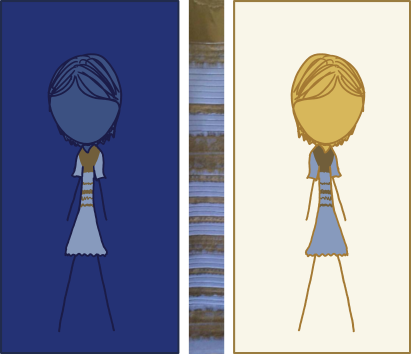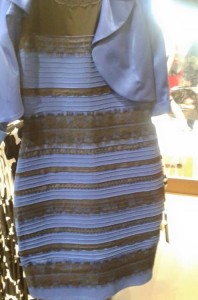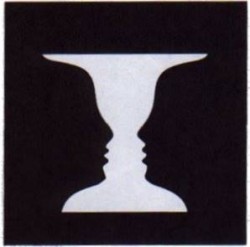You Probably Do NOT Have 4 Cones, What Else Is Wrong (or right) About the Goddamn Dress, and Some Fun Illusions
By now, you’ve either wondered just what color the dress is or you’re living under a rock in the middle of a deserted island with no internet and the first thing you chose to read when you were back online is my blog. Weird, but awesome.
The last few days have seen a flurry of education about our visual system and I won’t duplicate too many efforts here. But I would like to talk a bit about the illusion and the way the internet exploded with pseudoexplanations and other BS as a result. I’m going to spend a little more time on what this illusion does NOT mean.
First, the dress…
When the ugly white and gold dress first appeared in my feed last Thursday, I had the same reaction that I’m sure many of you did: this is a hoax.
I quickly determined that it was indeed real, immediately saw additional pictures of the blue and black dress, both in an online store and on the woman who wore it (BTW, as ugly as that dress is, she manages to pull it off), and started to think about what was happening. I fully accepted that the dress was actually blue and black, but I couldn’t perceive it that way in that photograph to save my life. It was fascinating!
At this point I should note that I have studied color vision and color perception since I was an undergrad. My first real experiment involved asking people to rate the facial expressions of expressionless faces drawn on backgrounds of different colors. The purpose of the study was to test the claims made… well, everywhere… that colors affect people’s emotions. I continued that line of research for more than 10 years and won several awards for it. My master’s thesis was titled “The Physiological Effects of Color on Human Emotion”. A summary of many years’ worth of findings is available here.
I also taught cognitive psychology (a portion of which involves sensation and perception) for several years and supervised a number of student experiments about color, some with very interesting results. What I am trying to say is that I have a good handle on what is causing the illusion. I was still mesmerized.
The illusion itself is not what I find so fascinating. What’s fascinating, and what caused it to blow up the internet, are the individual differences. Most polls only offered two possibilities, with about 70% claiming to see it as white and gold, 30% as blue and black, but I counted about 1 in 5 in my Facebook feed who said that it was sometimes white/gold and sometimes blue/black. I can recreate very similar illusions quickly using a basic drawing program, but illusions tend to be fairly universal. While we see some differences across cultures, mostly due to differing environments, I don’t think that I have ever seen people in the same household, looking at the same picture, perceive an image so differently and in a stable manner. Yet my youngest son saw only blue and black while the rest of the house saw white and gold. When it comes to ambiguous figures, such as the famous figure/ground image below, most people can perceive the image either way and reverse it at will. Of those who said that they sometimes saw the dress as white/gold and sometimes as blue/black, nobody I talked to said that they could switch the perception at will.
On Friday, post after post tumbled through my Facebook feed. The first posts I saw picked apart the image, extracting information about the color of the pixels. Well, that stuff is mostly irrelevant. Perception is much, much more than the simple sensation of the color of light hitting our eyes. The color of the dress in the photograph does not tell us the color of the dress (which we know from other sources) or why some people perceive the dress’s color as it is (blue/black) and some so differently (white/gold). Both, btw, are considered illusions since neither matches the pixels in the image, but nobody should perceive the dress as the pixel colors because they wouldn’t perceive it that way in person. Confused yet?
Next came all of the explanations. Some claimed to show us how we could perceive the dress differently, replete with not-quite-right explanations for why it’s happening. Yet I have met nobody who could force a different perception, at least not for more than a fraction of a second, much less using the methods suggested. Those doctored images just looked like doctored images to me. They did not change my perception that the dress was white with gold lace. Many gave some pretty bad explanations (those who saw blue/black do not have better color constancy). Some suggested that one’s sleep cycle could explain individual differences (it can’t). This guy says:
Your eyes have retinas, the things that let you interpret color. There’s rods, round things, and cones that stick out, which is what gives your eye a textured appearance in the colored part.
And that, my friends, is how a little bit of education can lead to dangerous things like deciding not to vaccinate your children. He has either skimmed Wikipedia’s entry on color theory or was half asleep through a half hour lecture in an intro psych class and now thinks he understands how eyes work.
And as of this writing that bit of BS has been RTed over eight thousand times.
My favorite bogus explanation: Mood. The color you see depends on your mood. That’s the one my kids heard the most during school that day.
And the jokes. Oh, the jokes. Some, like XKCD, were 10 kinds of awesome (make sure you read the alt text, and if you don’t get it, read this post). Others were not so funny.

Then, late Friday evening, after I’d taken a bit of a break from “the dress”, someone sent me this video and all hell broke loose. The video content isn’t relevant; it’s just a fun look at how to correct the photo. What is relevant is that suddenly the dress was BLUE AND BLACK. Not brown, not like an altered photo of a white and gold dress, but blue and black–the same royal blue that is in the other photos. I thought maybe the image in the video had been altered, so I pulled up a blog post with the original picture and it looked the same. I Googled “what color is this dress” and looked at the images. I saw a sea of blue/black dresses with one white/gold one in the corner. It looked to me like someone had replaced most of the pictures on the internet!
Since then the dress color switches for me. I usually see it as white with gold lace, but now and again it’s deep blue with black lace.
And I know why, yet I am helpless to control it.
And over the weekend, I started to see about-the-dress-here’s-some-more-BS-about-color-vision posts. Business Insider, which is becoming more and more like Buzzfeed every day, posted a number of pieces of varying quality. One of them had the unfortunate title, “No one could see the color blue until modern times”. The piece itself isn’t bad. It speculates about the effect that naming colors has on perceiving colors. There is some evidence that cultures which fail to distinguish between blue and green perceive fewer distinct hues in that area of the spectrum, but to extract from that the idea that human beings didn’t “see” blue until they had a name for it? Well, that’s a preposterous leap that’s actually a bit silly. Why would they name something that didn’t exist?
Another which has been picking up steam in the last couple of days is this incredibly bad piece on linkedin which makes the bold claim that 25% of people have a 4th cone that allows them to “see colors as they are”. It’s a very strange thing to claim–to “see colors as they are”, since colors are simply the brain’s interpretation of wavelengths of light. In that sense, colors aren’t. They kind of don’t exist. The article talks about tetrachromacy, which is a real phenomenon, but the author basically made up the rest. I cannot fully explain color vision (or vision in general) in a blog post, but I can tell you this is wrong. Also, tetrachromacy is extremely rare, at least in functional form, and her “test” is totally bogus. The author calls herself “Prof. Diana Derval, expert in neuromarketing”. I know that it’s trendy to slap “neuro” onto everything, but really? Neuromarketing? Ugh. I first saw and responded to the piece on Facebook Sunday night and by Monday afternoon Snopes had covered it (they did a nice job, too, but they usually do), but that didn’t keep it from going viral.
So what is going on with the dress?
Well, several pieces have explained it with relative accuracy. I said I wouldn’t duplicate those efforts and I won’t. I will instead recommend that you read/watch more than one of those links, take a look at the additional illusions that I created below, and internalize this perfect summation:
“It’s an illusion,” said [David] Whitney. “But everything is an illusion.”
And that’s the long and short of it. What we “see” is never, ever exactly what’s out there in the world. It’s our brain’s best interpretation of what’s out there. We are amazingly good at it, but it’s not perfect and perfection is not possible.








I am going to read your master thesis chart but I have a question before I tackle it. How much do our brains automatic of color temperature changes play into this illusion? Or is that the main reason it works.
I have also seen lots of really bad science on TV and on the internet about the “dress” and was glad to see this addressed here.
[…] You Probably Do Not Have 4 Cones, What Else is Wrong (or right) About The Goddamn Dress, and Some Fun Illusions http://icbseverywhere.com/blog/2015/03/you-probably-do-not-have-4-cones-what-else-is-wrong-or-right-… […]
I can see both color schemes.
What makes the colors change for me is if I assume the picture was taken shortly after sunrise or at sunset. Morning looks blue and black. Sunset or evening, looks like white with gold lace.